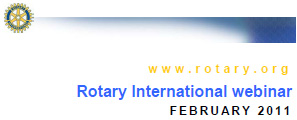Social media tips for clubs and districts
Posted by John Borst
on Feb 07, 2011
Are you personally using any of the social media portals such as Facebook, Twitter, or Linkedin? If so, has your Rotary club considered using these resources to promote and inform the public on your club's activity?
 On February 3rd, Rotary International held a professional development opportunity called a "Webinar" on social media use. Over 250 Rotarians from all over the world participated in this session.
On February 3rd, Rotary International held a professional development opportunity called a "Webinar" on social media use. Over 250 Rotarians from all over the world participated in this session.An audio visual record of the "Webinar" is available at https://www1.gotomeeting.com/register/685362360 (runs 1hr, 11 min, 25 sec)
In it you hear the voices of the various presenters and watch them navigate their various social media websites in real time as they talk. The panel includes Simone Carot Collins of the Rotary Club of Freshwater Bay, Perth, Western Australia (Facebook & Twitter); Randy Hollister, of the Rotary Club of Pawleys Island, South Carolina, USA (Facebook & Twitter); Henk Jaap Kloosterman of the Rotary Club of Voorburg-Vliet, the Netherlands (Linkedin); Melissa Ward of the Twin Bridges Rotary Club, New York, USA (blogs, Facebook)
Click on "more" to view 10 social media tips for clubs & districts:
1. View websites and social media as part of your public relations and marketing budget. Your online presence should not be an isolated expense or something for the “techie” person of the club to work on alone. It should have the club’s support, with several Rotarians involved.
2. Go online before you start your own social media page, and see what other clubs and organizations are doing. Note what you like and what you think would work well for communicating to the community and reaching your goals.
3. Develop a communications plan. This includes identifying an intended audience (e.g., prospective Rotarians, community leaders), goals (e.g., to let the community know what your club does, to find new members), and a message (e.g., “We’re a club that has a signature project,” “We’re a club that offers fun fellowship and service opportunities”).
4. Update your page regularly (but not too often) with photos, videos, and text. Plan to update your Facebook page at least once a week, but not five times a day. If you update too much, people will become overwhelmed and tune you out. If you don’t update enough, people will think your club is not active. Ask several club members (perhaps your committee chairs) to share the responsibility of updating your page.
5. Designate moderators. Check all social media sites for spam or other inappropriate comments nearly every day. Distribute the moderation duties among several people.
6. Look professional. Social media pages are a reflection of your club. Check your spelling, and use the Rotary emblem correctly. See http://www.rotary.org/graphics.
7. Be genuine, conversational, and fun. Share items that will interest your audience.
8. Reach out to other community organizations, especially potential project partners. Also connect with the news media and with local business and government leaders on Twitter and Facebook. Social media is about building relationships.
9. Promote your social media pages. Include links to them on your club’s website, in e-mails, and in print publications.
10. Be safe, but don’t be afraid. You won’t break the Internet! But remember that social media sites are public, so don’t include personal information. Also, sites can frequently change their policies, so review privacy settings regularly.
